Car head-up displays might not be the first car accessory on your shopping list, but trust us, once you experience the convenience of having crucial driving information directly in your line of sight, you’ll wonder how you ever drove without one. While they might seem like a luxury, HUDs are incredibly practical, primarily because they allow you to keep your eyes on the road.
With numerous car head-up displays available today, it can be challenging to discern which are genuinely worth your investment. Fortunately, we’ve rigorously tested a variety of head-up displays to identify the top performers, separating the hype from the truly valuable options.
Whether you’re looking for a device that syncs with your smartphone, your car’s onboard computer, or both, we’ve curated a list of the best car head-up displays currently on the market.
Top Car Head-Up Displays: Our Picks
At Tom’s Guide, our commitment is to provide trustworthy reviews. Our writers and editors dedicate significant time to analyzing and evaluating products to ensure you get the best recommendations. Learn more about our testing methodology.
1. Hudway Drive
Read our in-depth review
Specifications:
- Size: 7.3 x 6.3 x 4.0 inches
- Weight: 9.0 ounces
- Power: 12-volt accessory outlet
- Display size: 1.8-inches
- Color/Monochrome: Color
- Parameters Displayed: 11
- Alarms: Yes
Why Buy:
- Integrated projection screen
- Combines OBD2 and smartphone data
- Clear and readable display
Considerations:
- Bulky design
- Higher price point
The Hudway Drive stands out as a comprehensive car head-up display, seamlessly integrating data from your car’s OBD2 port, GPS satellites, and your smartphone. While it doesn’t offer Android Auto or Apple CarPlay integration, its ability to display a wealth of information directly in your field of vision justifies its position as a top contender.
Priced at $279, it’s among the pricier HUDs available. However, the extensive data it projects – from speed and RPMs to turn-by-turn navigation – makes it a worthwhile investment for drivers seeking comprehensive information at a glance. Keep in mind its larger size, and the potential for the screen to slightly obstruct your view.
Explore our comprehensive Hudway Drive Review
2. Pyle PHUD180BD
Read our expert analysis
Specifications:
- Size: 5.3 x 3.0 x 0.5 inches
- Weight: 4.4 ounces
- Power: OBD2 port
- Display size: 5.5-inches
- Color/Monochrome: Color
- Parameters Displayed: 14
- Alarms: Yes
Why Buy:
- Self-contained display screen
- Wide range of data readouts
- Bright and vibrant display
Considerations:
- Projection screen might be obstructive
- No smartphone integration
The Pyle PHUD180BD packs an impressive amount of information onto its 5.5-inch screen, particularly considering its budget-friendly price of around $67. While not the absolute cheapest HUD, it offers exceptional value, especially given its ability to merge OBD2 and GPS data.
Featuring a bright, large display and the capacity to present over two dozen vehicle parameters, the Pyle PHUD180BD is a top-tier car head-up display for the price. While the projection screen might occasionally be intrusive and it lacks phone integration, these are minor trade-offs for such a feature-rich device at this price point.
Dive into our detailed Pyle PHUD180OBD Review
3. Wiiyii C1 OBD + GPS
See our full review
Specifications:
- Size: 4.3 x 5.0 x 3.5 inches
- Weight: 4.4 ounces
- Power: 12-volt accessory outlet
- Display size: 1.8-inches
- Color/Monochrome: Color
- Parameters Displayed: 15
- Alarms: Yes
Why Buy:
- Integrated projection screen for clarity
- Utilizes both OBD2 and GPS data sources
- Foldable screen for unobtrusive storage
Considerations:
- Lacks smartphone connectivity
- No navigation capabilities
The Wiiyii C1 OBD + GPS head-up display is another excellent option that combines GPS and OBD2 data, presenting a wealth of information in an appealing visual format. This HUD is tailored for drivers who desire more data than their standard dashboard offers, providing access to parameters that automotive enthusiasts will appreciate. If you’re interested in monitoring metrics like air-to-fuel ratio or turbo pressure in real-time, the Wiiyii C1 is a strong contender.
Although it omits smartphone integration and navigation features, this HUD includes a self-contained projection screen, OBD2 fault code scanning and alerts, and a comprehensive suite of driving data. All this functionality is available at an attractive price of around $56.
Explore our complete Wiiyii C1 OBD + GPS Review
4. Akabane A500
Access our detailed review
Specifications:
- Size: 4.3- x 3.3- x 2.9-inches
- Weight: 5.1 ounces
- Power: OBD-II port
- Display size: 3.5-inches
- Color/Monochrome: Color
- Parameters Displayed: 60
- Alarms: Yes
Why Buy:
- Combines OBD2 and GPS data for comprehensive metrics
- Direct view display for ease of reading
- Displays a vast number of parameters
Considerations:
- Somewhat bulky and less refined design
- Can obstruct the driver’s view
- Menu interface can be initially complex
The Akabane A500 car head-up display, integrating both OBD2 port and GPS satellite data, offers capabilities beyond many other HUDs. Besides displaying a wide array of vehicle information, it includes performance testing features for braking and acceleration, appealing to performance driving enthusiasts. Want to verify your car’s 0-60 mph time? The Akabane A500 can assist (though always test responsibly and legally).
While its menu system might require some initial familiarization and the 3.5-inch screen isn’t the largest, it provides a wealth of useful driving data. OBD2 connectivity also enables fault detection within your vehicle’s systems. Its affordable price further enhances its appeal.
Read our full Akabane A500 Review
5. Autool X95 GPS Slope Meter
View our expert review
Specifications:
- Size: 3.3 x 3.2 x 2.2 inches
- Weight: 2.9 ounces
- Power: 12-volt accessory outlet
- Display size: 2.1-inches
- Color/Monochrome: Color
- Parameters Displayed: 6
- Alarms: No
Why Buy:
- GPS data integration for accurate positioning
- Tilt and roll angle sensors for off-road driving
- Direct view display for simplicity
- Accessory adapter includes dual USB power ports
Considerations:
- No OBD2 data integration
- Tall design may slightly impede visibility
- Lacks smartphone integration
For those venturing off the beaten path, the Autool X95 GPS Slope Meter is a specialized car head-up display to consider. Utilizing GPS and internal sensors, it presents standard driving information alongside specialized data for off-roading. Tilt and roll sensors provide crucial alerts when approaching vehicle stability limits.
Although it doesn’t access OBD2 data, limiting some common HUD functionalities, its unique features cater specifically to off-road drivers. The compact, lightweight design and user-friendly interface make it an excellent choice for this niche, despite its limitations for typical highway driving.
See our complete Autool X95 GPS Slope Meter Review
Key Features to Consider in a Car Head-Up Display
The best head-up displays effectively present essential vehicle operating parameters in a format that is easily visible and quickly understood. Standalone HUD units often surpass built-in systems in many modern cars due to their broader data display capabilities. However, they generally do not integrate with in-car entertainment or navigation systems.
Car head-up displays vary significantly. Beyond size and shape differences, the range of displayed information can differ dramatically. Some HUDs merely mirror basic dashboard data like speed and time, while others offer advanced metrics such as tachometer readings and fuel economy.
Many HUDs extend functionality to include data not directly related to immediate driving safety but still of interest, such as turbocharger boost pressure and altitude. For off-road enthusiasts, some models even provide roll-over warnings.
The most advanced HUDs offer smartphone connectivity, displaying turn-by-turn navigation, contact details, and even text messages. At the high end, some HUDs support Android Auto or Apple CarPlay, providing a modern infotainment interface if your vehicle lacks one.
Regardless of features, a HUD’s primary function is to display desired data without distracting the driver from the road. Screen size plays a critical role; larger screens improve readability but can also obstruct vision. Smaller screens are less intrusive but might compromise readability.
HUD screen technology also varies. Direct-view displays are generally larger, while projector-based HUDs project information onto a reflective surface, sometimes the windshield. Projections can create a large virtual image (up to 10 inches) but may suffer from visibility issues in bright sunlight.
Projector HUDs with fold-down screens offer improved clarity compared to windshield projections. These screens can also be retracted when not needed, ensuring an unobstructed view.
Color displays significantly enhance information presentation, allowing designers to display more data in a compact format. Button layout is also crucial; simple, intuitive interfaces are preferable to complex, multi-layered menu systems navigated by a single button.
Finally, consider data and power sources. OBD2 port connectivity provides access to a wealth of vehicle system data, though not as comprehensively as a dedicated OBD-II scanner. GPS provides data like speed and altitude. GPS-only units require a separate power source, often the car’s cigarette lighter socket.
Installation is generally straightforward, typically taking only minutes. The most challenging aspect is often cable management, tucking wires into dashboard crevices. Flat cables can simplify this process compared to round cables. Units usually mount on the dashboard using adhesive pads or strips.
Cost Considerations for Car Head-Up Displays
Entry-level head-up displays are available for under $20, but these often compromise on quality, with monochrome displays or limited data output (e.g., only speed).
Moving up to the $30-$70 range unlocks a wide selection of functional HUDs. High-end models can exceed $250, but are less common.
These premium HUDs justify their price with comprehensive features, stylish designs, and multi-source data integration, including smartphone and OBD2 data.
Our Car Head-Up Display Testing Process
Our head-up display testing begins in the garage with setup and positioning, crucial for all in-car accessories. We ensure the display is both functional and non-obstructive to the driver’s view.
Next, we address wiring – often simpler than anticipated but vital for secure and sufficient power delivery. We verify ample cable length for each device.
We then conduct startup and shutdown timing tests, measuring how quickly each HUD boots up and displays data upon engine start, and how quickly it powers down after engine shutoff.
Display quality and interface design are assessed for sharpness and user-friendliness. We thoroughly explore each device’s menu system and controls, noting ease of use and efficiency. We document the range of available settings for each HUD.
Road testing is critical. We evaluate real-world usability, assessing display performance under varying lighting conditions and during different driving maneuvers (acceleration, deceleration). We note any issues encountered during normal driving.
Finally, we test specialized features like text display, inclinometers, and turn-by-turn navigation, evaluating their effectiveness in practical use.
Alt texts for images:
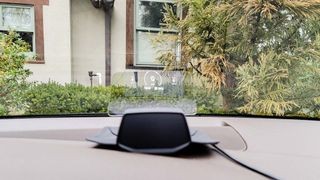{width=320 height=180}– alt=”Hudway Drive head-up display projecting driving information onto a screen mounted on a car dashboard, showcasing its integration as an OBD2 HUD.”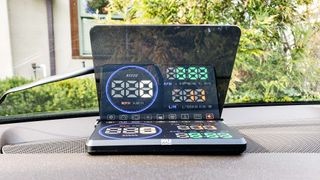{width=320 height=180}– alt=”Pyle PHUD180BD OBD2 head-up display in action, displaying speed and other vehicle data on its screen, installed on a car dashboard.”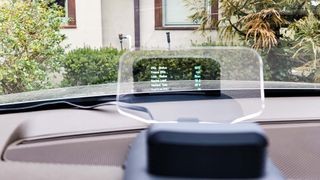{width=320 height=180}– alt=”Wiiyii C1 OBD and GPS head-up display presenting a range of vehicle parameters on its projection screen, positioned on a car’s dashboard.”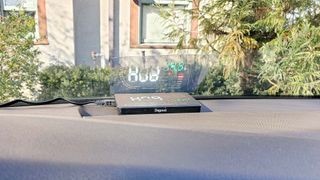{width=320 height=180}– alt=”Akabane A500 car HUD showing performance data and vehicle information on its direct view display, set up on a vehicle dashboard, highlighting its OBD2 capabilities.”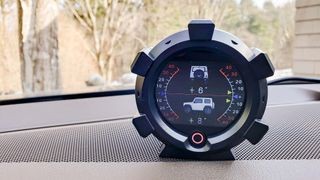{width=320 height=180}– alt=”Autool X95 GPS Slope Meter head-up display displaying tilt and roll angles, designed for off-road use and mounted on a car dashboard.”
